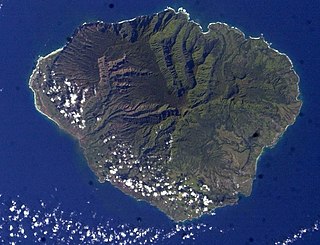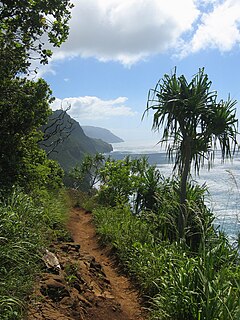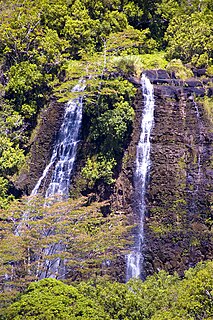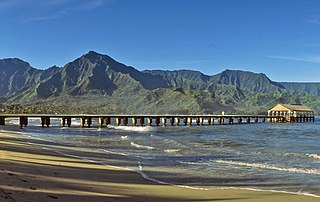
Kauaʻi, anglicized as Kauai, is geologically the second-oldest of the main Hawaiian Islands. With an area of 562.3 square miles (1,456.4 km2), it is the fourth-largest of these islands and the 21st largest island in the United States. Known also as the "Garden Isle", Kauaʻi lies 105 miles (169 km) across the Kauaʻi Channel, northwest of Oʻahu. This island is the site of Waimea Canyon State Park.

Wailua is a census-designated place (CDP) in Kauaʻi County, Hawaiʻi, United States. The population was 2,254 at the 2010 census, up from 2,083 at the 2000 census.
Wailua, Hawaiian for two waters, may refer to:
The following is an alphabetical list of articles related to the U.S. state of Hawaii:

Hurricane Iniki was the most powerful hurricane to strike the U.S. state of Hawaii in recorded history. Forming on September 5, 1992, during the strong 1990–1995 El Niño, Iniki was one of eleven Central Pacific tropical cyclones during that season. It attained tropical storm status on September 8 and further intensified into a hurricane the next day. After turning north, Iniki struck the island of Kauaʻi on September 11 at peak intensity; it had winds of 145 mph and reached Category 4 status on the Saffir–Simpson hurricane scale. It had recorded wind gusts of 225 as evidenced by an anemometer that was found blown into the forest during clean up. It was the first hurricane to hit the state since Hurricane Iwa in the 1982 season, and the first major hurricane since Hurricane Dot in 1959. Iniki dissipated on September 13 about halfway between Hawaii and Alaska.

Hurricane Iwa, taken from the Hawaiian language name for the frigatebird, was at the time the costliest hurricane to affect the state of Hawaiʻi. Iwa was the twenty-third tropical storm and the twelfth and final hurricane of the 1982 Pacific hurricane season. It developed from an active trough of low pressure near the equator on November 19. The storm moved erratically northward until becoming a hurricane on November 23 when it began accelerating to the northeast in response to strong upper-level flow from the north. Iwa passed within 25 miles of the island of Kauaʻi with peak winds of 90 mph (145 km/h) on November 23, and the next day it became extratropical to the northeast of the state.

The Wailuā River is a major river on the island of Kauaʻi in the U.S. state of Hawaii. 20 miles (32 km) long, it is Kauai's largest and longest river, as well as Hawaii's 3rd longest river. It is formed by the confluence of its North and South forks just west of Wailua and enters the Pacific Ocean at 22°2′42″N159°20′11″W. It is the only navigable river in the Hawaiian Islands. It is a center of activity for locals and visitors in the form of boat tours to Fern Grotto, kayaking and water skiing.

The Kalalau Trail is a trail along Nā Pali Coast of the island of Kauai in the state of Hawaii. The trail runs approximately 11 miles (18 km) along the island's north shore from Keʻe Beach to the Kalalau Valley. The trail has been named one of the most beautiful, and dangerous, hikes of the United States.

Wailua River State Park and the Wailua Complex of Heiaus, which it includes, are located on the eastern side of the Hawaiian island of Kauai. The park consists primarily of the Wailua River valley, which is the only navigable river in Hawaii. Visitors to this park can kayak, take riverboat cruises and explore the rainforest. Even motorboats and water skiing are permissible on the river.
Coco Palms Resort was a resort hotel in Wailuā, Kauaʻi, Hawaiʻi, that was noted for its Hollywood connections, Hawaiian-themed weddings, torch lightings, destruction by a hurricane, and long-standing land disputes. The resort includes or is near to culturally significant spots and the sites of some of most important legends and historical events for Native Hawaiians.
Route 56, also known as Kuhio Highway, is the main highway on the north and east shore of Kauaiʻi island in Kauai County, Hawaii, United States.

Newcomb's snail is a species of air-breathing freshwater snail, a gastropod mollusk in the family Lymnaeidae. This species is endemic to Hawaii, in the United States. Its natural habitat is rivers. It is threatened by habitat loss.

ʻŌpaekaʻa Falls is a waterfall located on the ʻŌpaekaʻa Stream in Wailua River State Park on the eastern side of the Hawaiian island of Kauai. It is a 151–foot waterfall that flows over basalt from volcanic eruptions millions of years ago. Below the ridge down into the ravine through which the water falls can be seen the vertical dikes of basalt that cut through the horizontal Koloa lava flows. The name "ʻŌpaekaʻa" means rolling shrimp, "ʻopae" being Hawaiian for "shrimp," and "kaʻa" for "rolling". The name dates back to days when the native freshwater shrimp Atyoida bisulcata were plentiful in the stream and were seen rolling and tumbling down the falls and into the churning waters at the fall's base.

The ʻŌpaekaʻa Road Bridge is a steel truss bridge listed on the National Register of Historic Places located along ʻŌpaekaʻa Road in the Wailua Homesteads neighborhood of Kapaʻa, on the island of Kauaʻi, in the state of Hawaii, United States. The one-lane bridge spans ʻŌpaekaʻa Stream. With steel beams forged in 1890 by the Alexander Findlay & Company in Motherwell, Scotland, this is touted as possibly the only British-built bridge located in the United States.

Hanalei Pier is a pier built into Hanalei Bay on the northern shore of the island of Kauaʻi in the state of Hawaii.

Hurricane Fernanda in 1993 was the first significant hurricane threat to Hawaii since Hurricane Iniki struck in September 1992. The seventh named storm and fourth major hurricane of the 1993 Pacific hurricane season, Fernanda developed on August 9 off the coast of Mexico from a tropical wave. Throughout its life, it was a large system, and the hurricane reached peak winds of 145 mph (230 km/h). After weakening slightly, Fernanda restrengthened and was expected to move across the Hawaiian Islands. Instead, the hurricane slowed its forward motion and turned away from the state, although it still produced high waves along the eastern shore of the islands. Several homes were damaged, and the surf damaged coastal roads. The storm also contributed to rainfall across the state, and minor flooding occurred in Kauai. Fernanda became extratropical on August 19, and after turning to the northeast became absorbed by a cold front.

The Puʻuʻōpae Bridge is a one-lane, single-span, concrete-encased steel bridge across Kalama Stream located along Puʻuʻōpae Road between Kalama and Kīpapa Roads in the Wailua Homesteads area near Kapaʻa in Kauaʻi, Hawaiʻi, United States. Originally built in 1915, it was listed on the National Register of Historic Places in 2005.

The Royal Coconut Coast is the designation given to Kauai’s east side, defined as the area between the Wailua Golf Course, heading north along the coast to Kealia Beach, and extending inland towards the center of the island, to Mount Waialeale. The Royal Coconut Coast includes the sacred Wailua River area and the large towns of Wailua and Kapaa. The area derives its name from the acres of coconut trees located along the coast and highway. The area also hosts many places of historical and cultural significance, some of the land held as sacred and was once reserved only for the royalty of Hawaii.
Smith's Kauai is a family business established by Walter Smith, Sr. and his wife Emily on the Wailua River and Wailua River Valley. It began with a rowboat and borrowed outboard motor and has expanded to include the Fern Grotto Wailua River Cruise, Smith's Tropical Paradise (a 30-acre botanical and cultural garden), Smith's Weddings In Paradise and the Smith Family Garden Luau. The offerings take place on a 4th generation estate in Wailua Marina State Park, Kauai. Walter "Freckles" Smith II is the proprietor and it is known for its kalua pork luau prepared in an imu oven.

The Hanapepe River is a river on the Hawaiian island of Kauai. It begins at the confluence of the Kō'ula River with the Manuahi Stream and flows generally south for 5.3 miles (8.5 km) to its mouth at Hanapepe and Eleele in the Pacific Ocean. The watershed covers an area of 27.7 square miles, draining roughly a twentieth of the island. The name Hanapepe translates to "crushed bay," which may refer to landslides in the area.
















